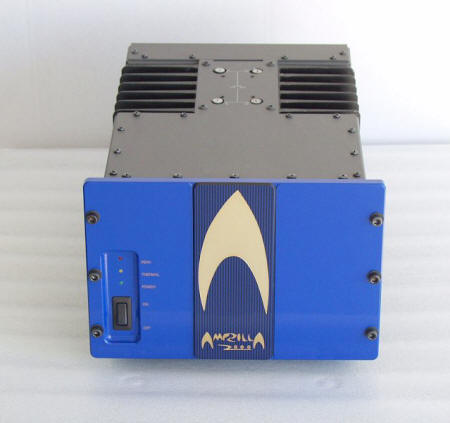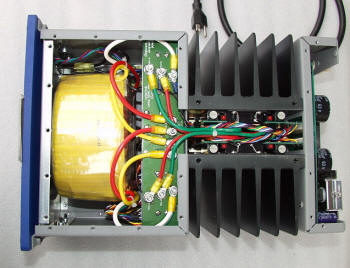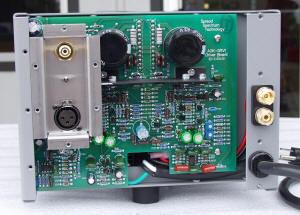Passion. Our hobby/interest/vocation is all about passion. There is a lot of passion in the high-end audio universe and James Bongiorno, the head of Spread Spectrum Technologies, has a consuming passion for his creations. He has been building and refining the Ampzilla amplifier concept since 1974 and holds a patent on the design. From his Web site:

“At the time, James was the director of engineering at SAE. Prior to that he had been the director of engineering at Dynaco where he created the renowned Dynaco 400. While at SAE, James conceived the concept of the full dual differential full complementary amplifier topology which has since, for the last 27 years, become the defacto world standard road map for virtually all high end power amplifiers made today. Ampzilla was originally designed as a construction project for Popular Electronics Magazine. However, the response was so overwhelming, after the rave reviews, that James left SAE to found “The Great American Sound Co. Inc.” (GAS CO.). The rest was history.” Read more here.
The Ampzilla 2000 amplifier, a 200 Watt (into 8 Ohms) mono block, is the latest thinking from the mind of James B. It is relatively compact, runs warm but not hot, and weighs a manageable 52 pounds. There is a single pair of speaker terminals and inputs for RCA and XLR interconnects. Interestingly, in the Owners Manual, the point of manufacture is listed as Cullen Circuits, also the manufacturer of the Wyred4Sound ST-1000 amplifier, which was reviewed here on 10Audio.com. Based on my experience with the high quality of other Cullen Circuits’ products, SST’s selection of Cullen to build his amps was a wise choice. Personally, I was especially pleased to see the selection of an on-shore, US manufacturer to produce a new product.
Last year provided several notable excursions into the current state of the art in solid state amplification. Figuring prominently in this survey were models from Pass Labs, BAT, Marantz, Wyred4Sound, Halcro, and Ampzilla. I have associated high end sound with tube amplifiers for literally decades, and last year provided opportunities to test whether or not solid state amplification had progressed to the point where it might be a satisfactory substitute for the tube amplifier that was currently holding the reference status in my review system. The amplifier to reign as reference was the outstanding Manley Neo-Classic 250 monos, so any contender for reference status would have to prove itself to be more involving and enjoyable than the very high performance level provided by the Manleys. If you have been reading 10Audio.com for a while, you might see that the $15,000 Marantz MA-9S2 amplifiers meet and in some ways exceed the performance of the $9,000 Manleys. Could the blue, $7,500, latest generation Ampzillas compete at this very high level of performance?
The Ampzilla 2000 amplifiers are perfectly smooth sounding with no grain, just like a good tube amplifier. Unlike many tube amplifiers, the Ampzillas are very extended in the bass and treble. The bass is simply outstanding. It goes down very deep into the lowest bass with super high resolution. The bass is perfectly tight and detailed, while not sounding dry and lacking realistic bloom. This is the perfect combination of objectively excellent and subjectively excellent. Many other solid state amps emphasize the qualities of tightness and definition at the expense of realistic warmth and bloom. The Ampzilla 2000 just “nails” the bass perfectly. This amplifier is a dream come true for bass lovers.

There is excellent consistency in the tonal balance between octaves. This is clearly audible on piano where the delicate but complex harmonic structure of each note must be perfectly maintained in each higher octave or else the piano will sound false and unconvincing. Largely due to this consistent character from the bass to (seemingly) dog whistle-high treble, the piano has a rare – for electronic systems – truly lifelike presence and accessibility. Horns have a rich metallic texture that reaches very deeply into each note. The sound of air moving through the instrument is clearly rendered. A difficult challenge for any audio component, well recorded brass instruments can edge towards brightness with only an occasional sense of getting a bit too close to that harsh precipice. This is also an area where super amps, which start in the 5 figure price range, can stumble from time to time. This finds the Ampzilla as a close neighbor to some of the best amplifiers available today.
The soundstage is an odd combination of excellent lateral localization with a minor deficiency in the sense of the depth of the performance stage. Where the Marantz mono amps routinely ignore the speaker positions and place instrument outside the limits of the speakers, the Ampzilla amplifiers followed the much more common presentation of the stage being between the two speakers. This is not really an issue unless you have been spoiled by electronics that have the ability to consistently make the speakers audibly disappear.
Many amplifiers give an unreal sense of the placement of performers in an orchestra, highlighting the sense of the layered depth of the various instrument sections. The Ampzilla amps offer less of the individual layers and more of a continuous sound from front to back of the stage. I find this to be more like the sound that I hear when I go to hear the Colorado Symphony Orchestra perform in Denver. (Their recent performances of music from Star Trek, and accompanying Three Dog Night, were lots of fun!) I listen closely for those audiophile characteristics we use to judge audio components and often find them to be somewhat removed from the sound of live acoustic performances. The Ampzillas offer a mid-hall perspective, where performers sit “to the left”, or “far on the right”, instead of stereo system perspectives of exactly and specifically “right there” (pointing directly at the performer). This is a more general localization, and more real for this type of performance. Studio, multi-track mixes often offer more exact image placement, with an excellent center image, and for electronic studio music, the soundstage presentation of the Ampzilla amps is quite satisfying, too.

The dynamic ability is special. While the Ampzilla amps offer a mid-hall perspective on the soundstage, there is a front and center view of clarity and immediacy. The 200 watt power rating is obviously conservative because the headroom is seemingly limitless, with no change in character from very quiet to extremely loud. For macro-dynamics, the Ampzilla is very close to the outstanding ability of the Halcro MC20, which is a champ in this area. The $7,500 BAT VK250SE does not approach the Ampzilla for dynamics, and BAT’s slightly grainy picture is not competitive with the smooth and clear window offered by the Ampzilla. Low level resolution is also very accomplished. It is easy to hear a pick slide over guitar strings or the mallet strike a bass drum. These impulses are fast and clean, and the Ampzilla amps present them realistically.
The fade or harmonic trail of any well recorded note sounds exactly as it should, maintaining the initial tone and pulse of the original note as it decreases in loudness and increases in frequency in a perfectly linear manner. From acoustic bass to violin, it is easy to follow the vibration of individual strings. This sense of drama is enhanced by effortless changes in volume from near-silence to startlingly loud. Even though the pressure of the loudest sounds can be intense, it is very rare to feel the need to turn the volume down due to personal overload. In fact, I often found the volume to be at a louder level with the Ampzilla 2000 than I used with some of the competition: it just sounds great played at high levels.
There is only one area where I would have wished for a slightly different character. There is a small sense of forwardness in the upper midrange. This sense went largely unnoticed after listening to the amplifiers for a week or so, but changing back to the Marantz or Manley monos brought this character back to mind. Other than this – and it is important to stress that another system might highlight a different specific trait to mention – the overall balance was musically correct and very enjoyable, and listening fatigue was almost nonexistent even after long – and loud – listening sessions. The big Marantz monos have a better sense of ease and natural flow that earned it an easy 10 LP rating, and the Ampzilla amplifiers are not far behind.
The Ampzilla 2000 has a powerful dynamic character and exceptional harmonic accuracy. It is not a sleepy, background music kind of component. It demands that you sit up straight and pay attention. When you do, you are rewarded with a musically rich and vibrant presentation that will keep you transfixed in the listening seat for hours at a time.
Overall Rating: 9.5 LPs
Link to manufacturer’s Web site: Spread Spectrum Technologies
My thanks to Walter Liederman at Underwood Hi-Fi. This review would not have been possible without Walter’s kind assistance.
Tags:
